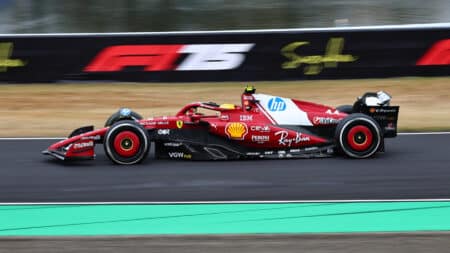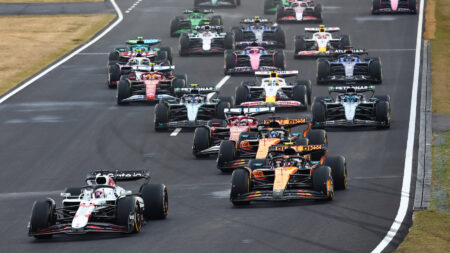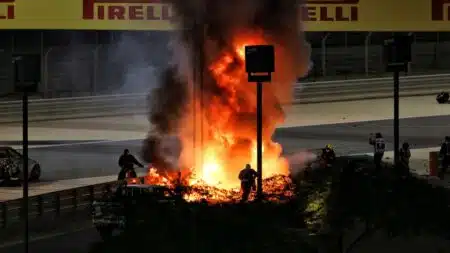
The Ferrari updates Hamilton hopes will fix his car problems in Bahrain
Ferrari is the Formula 1 team bringing the biggest update for its car in the Bahrain Grand Prix
This one had naked ambition written all over it, pretty appropriate given the venue. On his own doorstep Nico Rosberg showed what he was prepared to do to in his fight for this world championship – and he made it work. He showed that a ‘rich kid’ – as he’d been labelled by Lewis Hamilton in the lead-up to the weekend as the psychological warfare was notched up – was prepared to be a street fighter too, albeit a rather clever one.
His victory over Mercedes team-mate Hamilton was based on the all-important Monaco pole that his Mirabeau qualifying incident had helped secure him. That incident, which if you believe – as almost every other single driver in the paddock did – was deliberate, suggested the sort of resolve, ambition and thought of some other top players in the sport’s history when placed in similar situations.
Alain Prost used a similar approach against Ayrton Senna, Didier Pironi against Gilles Villeneuve: once they had arrived at the realisation that the guy in the other championship-contending car on the other side of the garage could drive it faster, they had to find some other way to compete with them.
Prost and Pironi did it out of the car, established relationships and bonds they hoped would give them a weapon the faster guy hadn’t thought of, because that faster guy was sometimes naïve in his belief that all he needed to be was more gifted than the other and that everything would follow from that. The parallels in 2014 aren’t difficult to see. So the guy that came into this race having suffered four straight defeats by his team-mate is now sitting Britney-pretty back in the lead of the championship, having taken a second consecutive Monaco victory.
The Britney nickname – coined by that great applier of team-mate psychological pressure Mark Webber when he and Rosberg were at Williams together – has stuck. Unsurprisingly, Nico doesn’t warm to it. In the competitive dynamic behind the scenes at Mercedes, Hamilton hasn’t been shy about jokingly encouraging team members to use the name.
Not a big deal in itself but indicative of the competitive tension between two guys who know how to win Grands Prix in the only car currently capable of winning them. It emerged during the weekend that in Spain Lewis had gone against team policy by turning up his engine to qualifying mode as he’d sought to defend against Rosberg. “Well, Nico did that in Bahrain,” Lewis pointed out.
These niggly flash-points aggregate the competitive ill-feeling. So when Hamilton crested the top of the hill out of Casino on what he was certain was going to be the pole lap and saw the yellow flags for Rosberg having gone straight on at Mirabeau, he inwardly kicked himself.
“It was my fault for not pushing harder on my first run,” he said, “because I should have realised he’d do this.” Rosberg’s first run had been 0.059sec faster than Hamilton’s and those turned out to be the only runs that counted once Nico had shot up that escape road.
So did he do it on purpose? The front-on shot was the most damning for him. It showed him sawing away at the wheel as if correcting a squirming rear end under braking – except the rear wasn’t squirming at all but simply following his lead on the steering.
He’d been a bit messy into Massenet, got quite out of shape over the Casino crest, ensuring he was already 0.1sec slower than his first run at the same point. He was further towards the centre of the track than you’d normally be there, but not by an outrageous amount and by the time he reached the turn-in point, visually the car was comfortably slowed down enough that he’d still make the turn.
1. N Rosberg, Mercedes 1h49m27.661s
2. L Hamilton, Mercedes +9.2s
3. D Ricciardo, Red Bull +9.6s
4. F Alonso, Ferrari +32.4s
5. N Hülkenberg, Force India +1 lap
6. J Button, McLaren +1 lap
7. F Massa, Williams +1 lap
8. R Grosjean, Lotus +1 lap
9. J Bianchi, Marussia +1 lap
10. K Magnussen, McLaren +1 lap
11. M Ericsson, Caterham+1 lap
12. K Räikkönen, Ferrari +1 lap
13. K Kobayashi, Caterham +3 laps
14. M Chilton, Marussia +3 laps
DNF
E Gutiérrez, Sauber 59 laps
V Bottas, Williams 55 laps
J-E Vergne, Toro Rosso 50 laps
A Sutil, Sauber 23 laps
D Kvyat, Toro Rosso 10 laps
S Vettel, Red Bull 5 laps
S Pérez, Force India 0 laps
DNS
P Maldonado, Lotus
Instead, he locked up his front brakes and headed for the escape road. The stewards later said they could ‘find no evidence’ that he’d done it deliberately. “Yes, of course it was deliberate,” said a multiple Grand Prix-winning colleague. “But he’s never going to tell anyone. He doesn’t need to.”
“I wish I could show you guys the telemetry,” said Lewis to the assembled British press.
So would Lewis have taken the pole had Nico completed his lap conventionally? “I was two-and-a-half tenths up on my target,” he asserted. He was referring to the advantage he knew he had over Rosberg in sector two – the main meat of the circuit, comprising 46 per cent of the lap time.
Coming near-enough to equalling Rosberg’s best in sector one put him potentially two-and-a-half tenths ahead of Nico over the lap. Through the short final sector, they’d been much the same all weekend.
Whilst not referring specifically to his qualifying incident, Rosberg conceded after the race that he really needed to halt Hamilton’s momentum here. Historically it’s a strong track for Rosberg and, looking ahead, Hamilton is invariably fantastically quick at Montreal, the following race. If Rosberg were to get beaten again by Hamilton here and Montreal, that would be six straight defeats. He could not afford that.
Who knows if he was stung by those ‘rich boy’ comments published a few days before the race, but his resolve, speed and his very strong first Q3 run secured him pole – and immediately took away Lewis’ delicate but recently bolstered equilibrium; moody, insinuating answers to questions, pointed non-comments, even an oblique reference to the Senna-Prost accident of Suzuka 1990. “I like how Ayrton dealt with it.”
So tensions were high as the two Mercs sat at the front of the grid waiting for the gantry lights to go out. But the run from there to Ste Devote was too short, and Rosberg’s start with his fresh clutch (the other one had been burned out as he manoeuvred around the Mirabeau escape road on Saturday) too good for Lewis to get close enough.
Maybe someone had also had a word about the dubious wisdom of impersonating Senna’s stunt in that in today’s F1 deliberately driving into another car, having previously said you were going to, would put points on your licence and might even earn you a race ban. He meekly followed Rosberg through Ste Devote ahead of the fast-starting Red Bull of Sebastian Vettel, Kimi Räikkönen’s Ferrari, the slow-starting Red Bull of Daniel Ricciardo, Fernando Alonso’s Ferrari and the rest.
So two of Monaco’s three potential race-winning moments – qualifying and the start – had now been spent and still Hamilton was behind. Given the severe limitation of realistic overtaking opportunities between identical cars at Monaco, the only feasible remaining opportunity was around the pitstops.
In this, a potentially fascinating picture was building. Knowing the traits of the Pirelli super-soft (option) and soft (prime) around an overcast Monaco, with a track temperature of just 28-deg C, is key to understanding the dilemma Mercedes was facing in which of its drivers would come out ahead after the stops.
One-stopping is invariably the fastest way around here and that was truer than ever this year. The conservative compounds of the 2014 Pirellis combined with the choice of just four compounds to cover the entire season meant that even the raciest possible choice of super-soft and soft was very understessed. Degradation was tiny on both compounds and the super-soft was much the faster tyre.
1. Nico Rosberg 122
2. Lewis Hamilton 118
3. Fernando Alonso 61
4. Daniel Ricciardo 54
5. Nico Hülkenberg 47
6. Sebastian Vettel 45
7. Valtteri Bottas 34
8. Jenson Button 31
9. Kevin Magnussen 21
10. Sergio Pérez 20
11. Felipe Massa 18
12. Kimi Räikkönen 17
13. Romain Grosjean 8
14. Jean-Éric Vergne 4
15. Daniil Kvyat 4
16. Jules Bianchi 2
But the warm-up rate of both was very slow, which meant that the usual technique of ‘undercutting’ – making up a place by coming in earlier than your rival and using the new tyre grip to go faster than he can go on his old tyres and thereby being ahead after he’s stopped – was not necessarily going to work. It could be that the fresh prime tyres could be slower than the warm old options for a lap or two, until they came up to temperature.
The way to get ahead might actually have been the ‘overcut’ – getting ahead by stopping later. But it was very finely poised. The driver ahead on the road – ie Rosberg – gets strategic preference. But which would be the better strategy? Being the first to stop or the second? Mercedes estimated the overcut would work, not the undercut. But because it was so finely poised, there was the sniff of opportunity in the air for Hamilton.
There was a realistic chance that whatever choice Mercedes made for Rosberg as the best guess would turn out to be wrong – and then Hamilton would be sprung clear. With track position, a clear track and his superior fuel usage potentially allowing him more power, he’d be up and gone. But it didn’t work out that way.
A lap 25 safety car for Adrian Sutil’s crashed Sauber made the pitstop call for everyone. Between the start and then, a few things of less significance had happened. Sergio Pérez spun on the exit of Mirabeau on the first lap, clunking Jenson Button’s McLaren as he did so and breaking the Force India’s suspension. This brought out the safety car.
Racing resumed going into lap four, by which time Vettel’s turbo had developed a mechanical fault and was no longer working. Several hundred horsepower down, he was passed by pretty much everyone in quick succession and then retired. The two Mercs quickly pulled away from Räikkönen, Ricciardo, Alonso, Kevin Magnussen’s McLaren and the Toro Rossos of Jean-Éric Vergne and Daniil Kyvat. The latter retired after 10 laps with oil smoke licking the exhausts.
Drivers were struggling to get heat into the tyres. Hamilton was even thinking his rears had gone off until being reassured that the temperatures were simply a little down and he should push harder rather than back off. The gap between Rosberg and him varied but generally hung around 1sec or so. The gap back to their pursuers was massive. Even around such a short track they were 12sec clear of the pack by the time the pitstop window began opening up.
As such, Mercedes didn’t need to consider the threat from the cars of other teams. Its sequencing dilemma was purely internal. By the 22nd lap fourth placed Ricciardo began lapping faster than the Mercs, albeit from a long way behind. It reflected how much the Mercs had been pushing earlier, when the fuel loads were heavy. But still they all stayed out, looking for the overcut. It was going to be a case of who blinked first and whose tyres would wear out first.
Then on lap 24 Sutil lost it. He’d been driving an aggressive race from the back, having been forced to pit for a new wing after getting involved in the Pérez first lap incident and was using his characteristic passing place of the old Loews hairpin. Then cresting the rise out of the tunnel, braking from 170mph, the car got light – and the classic accident there unfolded, the Sauber bouncing off both barriers and coming to rest just short of the barrier onto Tabac straight. He was unharmed but the car, minus a front wheel, was immovable.
The Mercs passed the accident site only about 10sec after it had happened. Hamilton immediately radioed in: could he pit now? The safety car was bound to be coming out. Negative, stay out, he was told. The logic of telling him that from the team’s perspective was obvious: they were not going to get passed by any rival team’s car no matter what. Better to play it conservatively, wait for the safety car to be deployed, then bring both drivers in together.
Had Lewis taken a leaf from Rosberg’s Saturday book, he’d have taken the decision out of the team’s hands. He’d simply have told them he was coming in, then arrived. They would have been obliged to service him. The safety car would then have been deployed, forcing Rosberg’s in-lap to be within the regulation delta time of the safety car – and so Hamilton would have jumped ahead. Instead, he did as he was told.
He’d been upset about the reception he got after disobeying the engine mode instruction at Barcelona. Perhaps he just couldn’t find it in himself to disobey again. The safety car was duly deployed and everyone made slowly for the pits, Lewis stacked behind Nico. Everyone’s options were exchanged for primes that would now do the remaining 53 laps.
There were a couple of exceptions to that: Felipe Massa, whose Williams had been circulating 12th, stayed out, jumping him up to sixth. Nico Hülkenberg’s Force India had actually started on the primes and so now switched to options – which would likely make them very worn by the end. The order behind the safety car: Rosberg, Hamilton, Räikkönen, Ricciardo, Alonso, Massa, Vergne, Magnussen, Hülkenberg, Button and Valtteri Bottas’s Williams.
1. Mercedes 240
2. Red Bull-Renault 99
3. Ferrari 78
4. Force India-Mercedes 67
5. McLaren-Mercedes 52
6. Williams-Mercedes 52
7. Lotus-Renault 8
8. Toro Rosso-Renault 8
9. Marussia-Ferrari 2
Alonso’s ERS had not worked properly off the line and didn’t kick in until turn three, but the Ferrari was otherwise working OK. Vergne’s release at the stops by Toro Rosso had been judged unsafe and he’d soon have to serve a drive-through.
As the lapped cars were allowed to un-lap themselves, so Max Chilton went to pass Räikkönen into Mirabeau. “I don’t know how he expected me to get out the way at such a tight corner,” protested Kimi. The Marussia’s front wing made contact with the Ferrari’s left-rear, puncturing it instantly – and sending Räikkönen straight back to the pits. With the field bunched as it was, this was especially disastrous for him.
The other Marussia of Jules Bianchi had lined up in the wrong grid position – confusion being caused as Pastor Maldonado’s Lotus was wheeled off the dummy grid as a non-starter. Bianchi’s error entailed a 5sec penalty which under this year’s rules can be taken at a normal tyre stop. However, the rules also state the penalty cannot be taken under the safety car. Which – if you weren’t planning to stop again – made it not altogether obvious when it could be taken.
What actually happens in such situations is that the time is simply added on at the end. But to be on the safe side, Marussia took the penalty at the stop as well. Bianchi would go on to drive a superb race from there, passing Kamui Kobayashi’s Caterham with a cheeky three-hit nudge at Rascasse. Attrition would do the rest – allowing him to bring the Marussia home eighth (ninth after the penalty was applied) giving the team its very well-earned first points after four years of toil. The car was much improved here, as also demonstrated by Chilton’s seventh ranking in the fastest lap list.
“I knew I should have come in as soon I saw Sutil’s car,” radioed Lewis. “I also knew you wouldn’t call me in, guys.” It sounded like paranoia, but was actually just his acknowledging of the team policy of giving the first driver first call. The restart came at the beginning of lap 31 and the two Mercs again ran away from the rest of the field and hid. Räikkönen’s puncture had brought Ricciardo up to third and he was able to keep a comfortable margin over Alonso.
Magnussen had jumped Vergne for sixth at the restart, but before the second safety car line after Nogues. He was obliged therefore to give it back. Just after he’d done this, Hülkenberg used his super-soft tyres and a bit of nerve to invent a new passing place – he went by Magnussen on the inside of Portier!
This left Magnussen now being harried by team-mate Button. Vergne fell out of this group with his drive-through on lap 37 and fell out of the race entirely when his engine failed 13 laps later. Massa finally pitted out of fifth for his one and only stop on lap 45, rejoining 11th. His 45-lap old super-softs still had 20 per cent of their rubber left. That’s how conservative the tyres were at Monaco.
Rosberg was flawless under plenty of pressure from Hamilton, especially as he was also heavily managing his fuel. Both Mercs had been significantly under-fuelled in the expectation of safety cars. Hamilton’s lower usage allowed him to be safe, but Nico was marginal. By lap 43 he’d used 49.68kg compared to Hamilton’s 48.1kg and this was after Nico had been lifting-and-coasting for a few laps. He eventually got it all back on schedule, whilst continuing to fend off the sister Merc in his mirrors.
“I’m not interested in the gap back to Ricciardo,” exclaimed Hamilton after being informed of it. “I want to know the gap between Nico and me.” But actually, he did need to know about the Red Bull – because suddenly Danny was flying, just as in the late phase of the first stint. Without anyone immediately ahead or behind, Red Bull was able to run its race with only the minimum time to consider rather than track positioning.
With its power unit, that entailed switching to a more powerful map at a time when Mercedes were in conservative mode. From lap 55 Ricciardo was lapping at Mercedes pace – and thereafter he was going faster still. It was a bad time for Hamilton to get something in his eye. “Something got sucked through the gap between the visor and my helmet,” he said, “and it went into my left eye. I tried closing it but you can’t really drive like that and twice I actually touched the wall. I managed to get my hand in there at the hairpin and eventually it cleared.” By which time the Red Bull was hard on his tail and the other Mercedes had disappeared a few seconds up the road. The pressure was finally off for Rosberg.
Alonso was lonely in fourth, unable to run at anything like Ricciardo’s pace and coping with a braking imbalance that was pulling the Ferrari to the right. But he was a long way clear of Hülkenberg who, as expected, entered the race’s late stages fighting very worn rear option tyres. Nonetheless he kept the McLarens behind him to take a tenacious fifth. Magnussen had a power unit problem with a few laps to go, allowing Button to pass him at the end of the pit straight and around the outside of Ste Devote.
Räikkönen, having battled his way past Caterhams and Marussias, was upon the slowed Magnussen with four laps to go and tried for the inside down into Loews. They both ran out wide and were forced to stop, allowing Massa, Bianchi and Romain Grosjean’s Lotus past. Räikkönen then pitted for a new front wing, had a set of new super-softs fitted and set the race’s fastest lap as a result, but he was out of the points. Very much in them though was the delighted Bianchi. Magnussen hung onto the final point.
The Mercs, despite a safety car a third of the way through the race, had lapped everyone from fifth place back. Rosberg’s victory puts him back at the head of the table, Hamilton a long-faced second and not even exchanging looks with his team-mate on the podium, let alone words, Danny standing to their side with his perma-grin in stark contrast to the stony straight-ahead stare of Lewis.
In the press conference Hamilton made pointed comments that he would be competing hard and fairly in the coming races and asked if he was planning to talk his issues through with Rosberg, replied: “I don’t have an answer for you on that one.”
No-one has an answer for the Mercs either, despite Ricciardo’s best efforts at a track that suits it best of all. Which is why war has finally broken out in the team with the dominant car, just as it invariably does in these situations. The names have changed but history is repeating.

Ferrari is the Formula 1 team bringing the biggest update for its car in the Bahrain Grand Prix

The FIA says engine manufacturers have committed to the planned 2026 rules, with some modifications

Over the years, the Bahrain Grand Prix has offered plenty of on-track - and some off-track - drama. These are the top controversies from the Sakhir event

The top three were covered by 2sec in the previous race, and big points were scored elsewhere – who's in your 2025 Bahrain GP Fantasy team? Here are our predictions; tips on drivers to avoid; which chips to play and further analysis